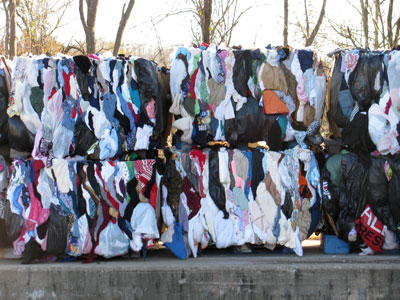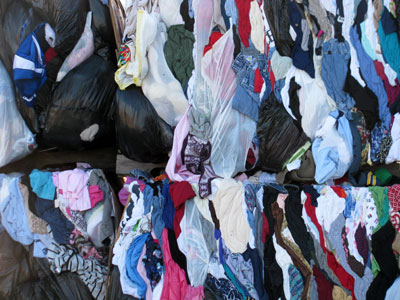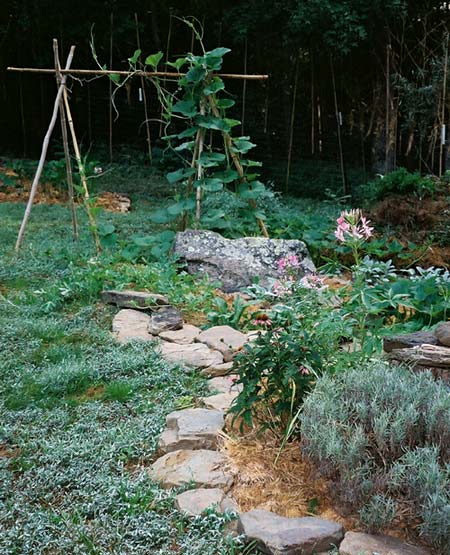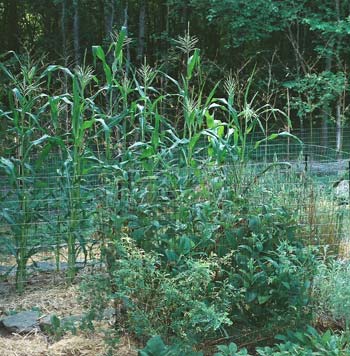With “developing” and wealthy nations now battling over obtaining their fair share of global carbon emissions, the belief that all people will someday enjoy the standard of living of the wealthy nations has become an unmistakable fantasy. Human societies are already in overshoot, consuming the resources of one and a third earths every year. If everyone on earth were to consume as much as people in the United States, humanity would be consuming the resources of five planet earths and there would soon be little of nature – or us – left. Yet the rising and very numerous middle classes in rapidly industrializing nations such as Brazil, India, and China are joining the shopping spree. Meanwhile one fourth of humanity, 1.4 billion, live on $1.25 or less per day and are unable to meet their basic needs.
The belief that the poor nations and poor people of the earth would eventually catch up and enjoy an abundant standard of living has allowed well-meaning people in the wealthy nations to act as if their own high incomes and consumption were unrelated to the poverty of others. Now that the limits of the earth are at hand the question “What is my fair share?” is getting tough to avoid. I want an answer to this question. I don’t want to participate in destroying nature and I don’t want to be responsible for other people living with hunger. But, I do want to live. How much can I have?

Stowell's Heirloom Corn from Seed Savers growing behind comfrey, astragulus, and sage plants.
To discover my fair share I started with statistics from the World Bank (World Development Indicators: 2008). The average per capita gross national income for the world in 2008, equalized by “purchasing power parity”, was $10,357. The purchasing power parity correction makes it easy to compare income in different countries, despite the fact that the same amount of money can buy much more in some countries than others. For example, you could buy half a dozen bananas in India for the same amount of money that would get you one banana in New York City (example from Norm Myers and Jennifer Kent in their book The New Consumers). The purchasing power parity correction rate for India is 5.35 (as of 2002). The international standard is the U.S. dollar so the same amount of money goes 5.35 times further in India than in the U.S. In other words if you are in the U.S. you can think of the $10,357 average world income as actual U.S. dollars. If you are in any other country, then you must use the purchasing power parity correction for your country.
But, the figure of $10,357 is the average gross national income, which is not the same as personal income because it includes things like the average amount of money your government spends on infrastructure. In 2008 gross national income in the U.S. was $46,970, but U.S. personal income before taxes was $40,189 and spendable income was $35,486 (Bureau of Economic Analysis, bea.gov). According to Myers and Kent, actual purchasing power for the world in 2002 was 60% of gross national income, corrected for purchasing power parity (and 70% for the U.S.). Let’s say then that my actual purchasing power would be roughly $6500 (somewhere between 60% and 70% of $10,357).
Whoops! What about Carbon?
But, wait! There’s a problem. At current levels of world income humanity is producing such a large quantity of greenhouse gases that we are threatening the continuation of human civilization and much of life on earth. The Global Humanitarian Forum, a think tank directed by former United Nations secretary general Kofi Annan, estimates that global warming is already causing 300,000 human deaths per year. To reduce greenhouse gases either income and related production must be reduced from the current world average (meaning I’d get less than $6500), world population must drop significantly, or every dollar spent must result in much less carbon entering the stratosphere. Damage to the environment is commonly calculated by multiplying these three factors (i.e. Impact=Population x Affluence x Technology). Both population (.7% per year) and income (1.4% per year) are growing. The most palatable option for the world’s rich is the third option, commonly known as reducing carbon intensity.
Carbon intensity can be decreased by increasing efficiency (producing goods and services with less energy) and by using non-carbon energy sources like solar power. Over the past 25 years carbon intensity has improved by almost 23% worldwide. But, this downward trend has not been consistent over the years. Since the year 2000 carbon intensity has worsened worldwide. With worsening carbon intensity, increasing income, and increasing population the total amount of carbon going into the atmosphere has increased by 3.5% per year since 2000 (up from under 1% in the 1990s). This rate of increase is far higher than the rates assumed in any of the models used by the Intergovernmental Panel on Climate Change in making its predictions of future global warming. Even with the Kyoto Protocol, no part of the world has succeeded in diminishing its carbon emissions.
Prosperity Without Growth, a recent report from the United Kingdom’s Sustainable Development Commission, has calculated the improvements in carbon intensity that would be necessary to offset projected growth in population and income between now and 2050 and still reduce carbon in the atmosphere down to 450 ppm. While in 2007 carbon intensity was at 768 grams of carbon dioxide per dollar we would need to get down to 36 grams per dollar by 2050. In other words carbon intensity would need to improve by 21 times! Remember that 25 years of technological improvements between 1980 and 2005 were only able to improve emissions 1.3 times (from 1000 to 768 grams carbon dioxide per dollar). This projection allows for slow income growth, but no equalization of income between rich and poor countries. If world income were to equalize at current European Union levels by 2050, allowing no income increases in the developed world, carbon intensity would need to diminish to 14 grams carbon dioxide per dollar, 55 times better than today. This last scenario presumes no income growth in the European Union, a loss in income for the U.S., and large gains in income throughout the developing world.
Prosperity Without Growth concludes that these levels of improvement in carbon intensity are not feasible and that economic growth cannot safely continue. Worldwatch attempted to put similar figures into perspective by pointing out that for everyone on the Earth to live at the EU levels expected in 2050 if “normal” growth continues we would need cars capable of getting 700 or 800 miles per gallon! It looks like even my fair share of $6500 is too much unless a revolution in technology dropped carbon intensity down to nearly nothing. Since new technologies take decades to come into common usage, the hope for such a revolution is just a fantasy, albeit a popular and dangerous one. The only other alternative – and this is just a personal solution – would be for me to find a way to spend my dollars on products and services that emit almost no carbon.
Shrinking Ecological Footprints
Carbon emissions are not the only constraint on growth. Globalized industrial patriarchy has been stripping the earth of every “resource” and is already butting up against other shortages such as water. The resource thieves in the “developed” world, myself included, must cut back their lifestyles. The world average gross income of $10,357 gives us a rough and too high upper limit and a clear message that drastic lifestyle cuts are called for since most people in the developed world have far higher incomes than this. Ideally, entire nations will take up the challenge to quickly dismantle their polluting systems and adopt new ways of life that involve far less consumption. While we as individuals are pressing for the massive social change needed, we can begin the process by changing own way of life and setting an example for others.
But, where to start? Whether setting about change at a national level or an individual level, a measure that quantifies how much different activities take from the earth is necessary. Here’s where calculating national or individual ecological footprints can help. With an ecological footprint analysis, the resources required to produce the specific products and services consumed can be estimated and translated into a land equivalent, measured in square yards, square meters, acres or hectares. For example, a pound of potatoes requires about 33 square yards of land if grown using industrial farming methods. The potato plants themselves use a small growing space, but the chemical input, farm machinery, and transportation to market all contribute to the footprint or land area required to produce the potatoes. Similarly, a kilowatt hour of electricity from the grid uses 31 square yards of land, while the solar equivalent takes under a third of a yard. A full ecological footprint for a nation or an individual is the land equivalent for everything consumed in a year.
In the United States the average ecological footprint for each person is 23 acres. But, if you divide the amount of productive land on the earth (2.8 billion acres excluding polar regions, deserts and deep sea) by the earth’s population of over 6 billion, the bioproductive land available to each person to produce everything consumed would be 5 acres. Therefore, in the U.S. we are each using 18 acres of land more than the earth can spare for us. These figures do not provide land for all the other species on the planet, so each person’s 5 acre allotment must be cut back further.
Jim Merkel’s excellent book, Radical Simplicity, provides detailed instructions for calculating your own ecological footprint, along with tables that show the land equivalent required for a wide range of products and services. As a longtime practitioner of radical simplicity Merkel has lived on $5000 and an ecological footprint of 3 acres of land for many years. His book describes scenarios for a life lived with a 1 acre, 3 acre, or 6 acre ecological footprint.
On 3 acres, an amount that is enough less than the world personal allotment of 5 acres to allow at least some room for wildlife, the sample lifestyle is far removed from that of the typical American. While plenty of veggies, fruit, beans and grains could be eaten, meat, dairy products, juice, and alcohol would be excluded from the diet because they require too many resources. The living space would be quite small (150 square feet or so) in a very energy efficient building such as a straw bale house. A very small allotment of fuel oil or firewood for heating would be possible. Transportation would be largely by bicycle or on foot with 50 miles of bus travel and a couple of gallons of gasoline allotted per month. Air travel would be impossible.
Returning to Traditional Lifeways: The Real Sustainability Revolution
If all of this sounds like returning to a third world way of life, then you are correct. The average ecological footprint of the low income nations is under 2.5 acres. The peoples of both Africa (3.4 acres) and Asia/Pacific (4 acres) consume less than their share of the Earth’s biocapacity while those in Latin America (6 acres) and the Middle East/Central Asia (5.7 acres) slightly exceed their share. People are obviously capable of living on less than a 5 acre footprint. Although some people in the global South have far too few resources, this does not mean that one cannot live well without overdrawing the Earth’s biocapacity. Deprivation results when traditional peoples have their ways of life disrupted by thefts of land, water, or other resources, as has happened to many, thanks to the powerful forces of first colonization and now globalization. Where necessary resources are still available and communities are left intact, traditional and truly sustainable ways of life continue (See Ecofeminism by Maria Mies and Vandana Shiva, 1993). The peasants and indigenous peoples still living largely traditional lives in direct interaction with the Earth and each other are the models that those of us living in the heart of globalized industrial patriarchy need. Although small scale, traditional cultures may (or may not) have problematic patriarchal social structures, these cultures are able to maintain the Earth’s fertility and health and do not require huge amounts of energy from dangerous energy sources.
People immersed in globalized industrial patriarchy view traditional ways of life as inferior because these lifeways have been the target of an enormous smear campaign since the era of European colonization and then the inception of industry. Traditional people (and this includes all our ancestors) leave the land and their traditions when the powerful forces of industrializing, colonizing or globalizing patriarchy take the land and destroy their communities. Forced into cities or other participation in the globalized patriarchy, the propaganda of the dominating culture eventually persuades most displaced people that the old ways of life are inferior or too hard. But, now it is time to reverse this process! We can recognize the value of traditional ways of life linked directly to nature and local communities, dismantle globalized industrial patriarchy, and build new subsistence cultures. The traditional lifeways of indigenous peoples, peasants of the global South, and our own ancestors are our models for sustainability. Many of these small-scale, traditional cultures are also models for equalizing distribution of resources and more equitable social relationships. Some have matriarchal social structures (matrilineal, matrilocal) and these cultures deserve the closest study. Low-tech, modern inventions like bio-intensive gardening and perhaps bicycling can also help us to build subsistence cultures, as can social practices like consensus decision-making and consciousness raising.
In contrast, the vision of “sustainability” put forward by most of the political and educated classes of the industrialized world leaves many of the deadly bases of the dominant society untouched: industrialization, consumerism, capitalism, inequity, domination, patriarchy. Almost all the books, government reports, and even non-governmental organizations proposing solutions to climate change assume that industrialized society must continue. They call for major changes in practice – energy efficiency, recycling, de-carbonizing energy sources, even sometimes for an end to inequity – but do not address the roots of the problem. How can a system based in domination (patriarchy) and greed (capitalism) and therefore dedicated to giving more power and more goodies to some people create equity among people and live in balance with the Earth? Why would a sane people who care for the earth want to gamble that an aberrant way of life can be reined in enough to preserve the climate when there are existing ways of life that have worked for our species for thousands of years? Perhaps there may (or may not) be ways to live with the earth that could include some benefits from modern technology, but revolutionary changes are needed, not a new consumerism and more of the same old patriarchy. Only by getting rid of the social elements that have created the climate crisis, poverty, and ecological overshoot – patriarchy, capitalism, domination, consumerism – will we save the Earth and save our Selves.
Writing about my fair share has not been easy, but the writing is the easy part. How will I ever get my income and ecological footprint down to a level that does not hurt the Earth and steal from much of humanity? One step at a time is my only answer. The largest part of our ecological footprint here at Cedar Hill comes from the miles driven in two four wheel drive vehicles, the firewood burnt for heating the house, and, to a lesser extent, the food we eat. Our automobile usage seems hard to modify at the present moment due to our remote location, rough roads, lack of public transportation and a commitment to eldercare for my mother. We are currently creating window quilts and sealing up the house more effectively to reduce firewood use. We’re also growing more of our food on site and moving away from trucking in garden inputs. Fortunately, reducing income does have a clear upside: less time spent working for money and more time available for fighting patriarchy, spending time in nature, and working and playing on the homestead!























